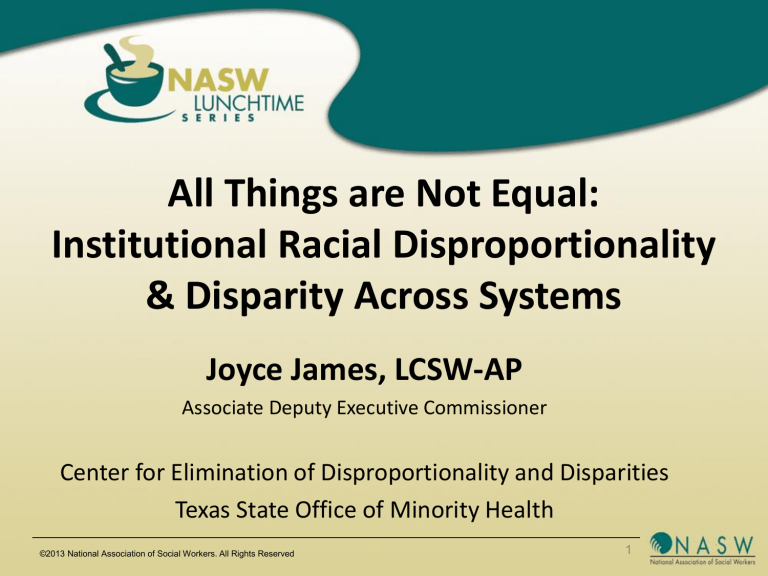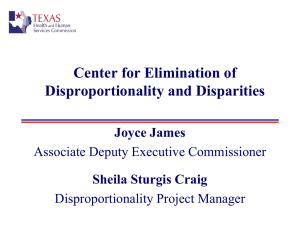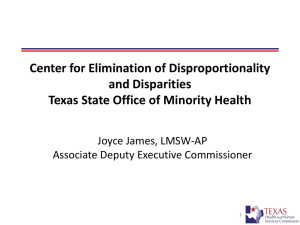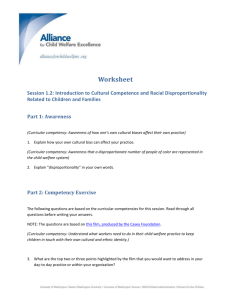
All Things are Not Equal:
Institutional Racial Disproportionality
& Disparity Across Systems
Joyce James, LCSW-AP
Associate Deputy Executive Commissioner
Center for Elimination of Disproportionality and Disparities
Texas State Office of Minority Health
©2013 National Association of Social Workers. All Rights Reserved
1
Mission of the Center for Elimination of
Disproportionality and Disparities
The mission of the Center is to partner with
health and human services agencies, external
stakeholders, as well as other systems and
communities to identify and eliminate
disproportionality and disparities affecting
children, families and vulnerable populations.
©2013 National Association of Social Workers. All Rights Reserved
2
Many terms are used to describe racial inequity
in outcomes across systems
Term
Definition
Most commonly
used in:
Disproportionality
The fact that some racial or ethnic groups of families and children are
represented in various child welfare services populations at levels that are
disproportionate to their numbers in the overall family or child population.A
Child welfare
Health Disparity
Differences in health outcomes and their determinants between segments of the
population, as defined by social, demographic, environmental, and geographic
attributes.B
Health and mental
health
Disproportionate
minority contact (DMC)
The disproportionate number of minority youth that come into contact with the
juvenile justice system.C
Juvenile justice
Achievement gap
The difference in the performance between each Elementary and Secondary
Education Act (ESEA) subgroup (Overall, Asian, Black, Hispanic, White, Free or
Reduced Price Meals, Limited English Proficient Students, and Special Education
Students) within a participating Local Education Authority (LEA) or school and the
statewide average performance of the LEA's or State's highest achieving
subgroups in reading/language arts and mathematics as measured by the
assessments required under the ESEA.D
Education
*Note: Practitioners within a discipline often disagree about precise term definitions. These examples are drawn from reputable
organizations and are intended to illustrate the general degree of similarity across systems.
Sources: A - Courtney, M., and Skyles, A. (2003). Racial disproportionality in the child welfare system. Children and Youth Services
Review, 25, 5, 355-358 B - Center for Disease Control and Prevention (2011). CDC Health Disparities and Inequalities Report. Morbidity
and Mortality Weekly Report. Supplement Vol 60. C - U.S. Department of Justice Office of Justice Programs (2012). "About DMC."
Retrieved 11/25/2012, from http://www.ojjdp.gov/dmc/about.html D - U.S. Department of Education (2012).
3
"Definitions." Retrieved 11/25/2012, from http://www.ed.gov/race-top/district-competition/definitions.
©2013 National Association of Social Workers. All Rights Reserved.
Terms
Term: Disproportionality
Definition*: The fact that some racial or ethnic groups of families
and children are represented in various child welfare services
populations at levels that are disproportionate to their numbers in
the overall family or child population.
Most Commonly Used: Child welfare
*Note: Practitioners within a discipline often disagree about precise term definitions. These examples are drawn from
reputable organizations and are intended to illustrate the general degree of similarity across systems.
Source: Courtney, M., and Skyles, A. (2003). Racial disproportionality in the child welfare system. Children and Youth
Services Review, 25, 5, 355-358
©2013 National Association of Social Workers. All Rights Reserved
4
Terms (continued)
Term: Health Disparity
Definition: Differences in health outcomes and their determinants
between segments of the population, as defined by social,
demographic, environmental, and geographic attributes.
Most Commonly Used: Health and mental health
Source: Center for Disease Control and Prevention (2011). CDC Health Disparities and Ineqalities Report.
Morbidity and Mortality Weekly Report. Supplement Vol 60.
©2013 National Association of Social Workers. All Rights Reserved
5
Terms (continued)
Term: Disproportionate minority contact (DMC)
Definition: The disproportionate number of minority youth that
come into contact with the juvenile justice system.
Most Commonly Used: Juvenile justice
Source: U.S. Department of Justice Office of Justice Programs (2012). "About DMC." Retrieved 11/25/2012, from
http://www.ojjdp.gov/dmc/about.html
©2013 National Association of Social Workers. All Rights Reserved
6
Terms (continued)
Term: Achievement gap
Definition: The difference in the performance between each
Elementary and Secondary Education Act (ESEA) subgroup (Overall,
Asian, Black, Hispanic, White, Free or Reduced Price Meals, Limited
English Proficient Students, and Special Education Students) within a
participating Local Education Authority (LEA) or school and the
statewide average performance of the LEA's or State's highest
achieving subgroups in reading/language arts and mathematics as
measured by the assessments required under the ESEA.
Most Commonly Used: Education
Source: U.S. Department of Education (2012). "Definitions." Retrieved 11/25/2012, from
http://www.ed.gov/race-top/district-competition/definitions.
©2013 National Association of Social Workers. All Rights Reserved.
7
Current (2007-2009) outcomes in Texas:
African Americans > 2x as likely to have poor outcomes in every system
Relative rate index for measures across child welfare, health, education, juvenile justice, and
criminal justice
Times more / less likely than whites
8,0x
7,0x
6,0x
5,0x
African-American
4,0x
3,0x
2,0x
Anglo
1,0x
Hispanic
0,0x
Education
CPS
Juvenile Justice
Criminal Justice
Health
Outcome
Source: The Interagency Council for Addressing Disproportionality (2011) Texas Health and Human Services Cross
System Data. Texas Health and Human Services Commission, Center for the Elimination of Disproportionality and
Disparities Texas State Office of Minority Health.
©2013 National Association of Social Workers. All Rights Reserved.
8
The Texas Model
Data-driven Strategies
Collect, research, analyze, and proactively share data on system outcomes by race and ethnicity
Leadership Development
Grow both systems and community leaders that are courageous and grounded in C.E.D.D. approach
Culturally Competent Workforce
Develop workforce that reviews and examines its work through an anti-racist and humanistic lens
Community Engagement
Recognize strengths of grass roots community, hear its ideas, and include it throughout process
Cross Systems Collaboration
Share data, training, and dialogue with systems, institutions, and agencies that serve same populations
Training Defined by Anti-Racist Principles1
Train staff and partners in principles that ensure we work at cultural and institutional levels
An Understanding of the History of Institutional Racism and the Impact on Poor
Communities and Communities of Color
Develop common analysis of racism and history that led to current outcomes
1. For example of Anti-racist principles see “The People’s Institute for Survival and Beyond”
http://www.pisab.org/our-principles
©2013 National Association of Social Workers. All Rights Reserved.
9
Texas Model
• Data-driven Strategies
Collect, research, analyze, and proactively share data on systems outcomes by
race and ethnicity
• Leadership Development
Grow both systems and community leaders that are courageous and grounded
in C.E.D.D. approach
• Culturally Competent Workforce
Develop workforce that reviews and examines it’s work through an anti-racist
and humanistic lens
©2013 National Association of Social Workers. All Rights Reserved
10
Texas Model
(continued)
• Community Engagement
Recognize strengths of grass roots community, hear its ideas, and include it
throughout process
• Cross Systems Collaboration
Share data, training, and dialogue with systems, institutions, and agencies that
serve same populations
• Training Defined by Anti-Racist Principles1
Train staff and partners in principles that ensure we work at cultural and
institutional levels
1. For example of Anti-racist principles see “The People’s Institute for Survival and Beyond”
http://www.pisab.org/our-principles
©2013 National Association of Social Workers. All Rights Reserved
11
Texas Model
(continued)
• An Understanding of the History of
Institutional Racism and the Impact on Poor
Communities and Communities of Color
Develop common analysis of racism and history that led to current outcomes
©2013 National Association of Social Workers. All Rights Reserved
12
Rate of removal
(Removals / Allegations)
The Texas Model led to a statewide decrease in
removal rates between 2005 and 2010
10%
Rate of removal by racial group
9%
8%
7%
African-American
6%
5%
Anglo
4%
Hispanic
3%
Disparity
(= African American Rate
– Anglo Rate)
2%
1%
0%
FY 2005
FY 2006
FY 2007
FY 2008
FY 2009
FY 2010
Year
Source: The Interagency Council for Addressing Disproportionality (2011) Comparison of Stages Data.
Texas Health and Human Services Commission, Center for the Elimination of Disproportionality and
Disparities Texas State Office of Minority Health.
©2013 National Association of Social Workers. All Rights Reserved.
13
The decrease was most pronounced in counties
where the Texas Model is most developed
African American removal rates pre- and post intervention
7%
6%
.6%
1.2%
5%
2008
2%
2005
3%
2008
2005
4%
1%
Pre-
0%
5 Focus Counties
All Texas Counties
Anglo removal rates pre- and post intervention
6%
5%
.1%
.6%
4%
2008
2005
2%
2008
3%
2005
Focus counties (Harris,
Tarrant, Dallas, Travis,
Jefferson) began
community engagement
in 2005, 2 years before
the rest of the state
1%
0%
5 Focus Counties
All Texas Counties
Source: Baumann, D. J., Fluke, J. Graham, J. C., Wittenstrom, K., Hedderson, J., Riveau, S., Detlaff, A., Rycraft, J.,
Ortiz, M. J., James, J. Kromrei, L., Craig, S., Capouch, Sheets, J., Ward, D., Breidenbach, R., Hardaway, A., Boudreau,
B., and Brown, N. (2010).Disproportionality in Child Protective Services: The Preliminary Results of Statewide
14
Reform Efforts. Provided to the Texas Department of Family and Protective Services. March.
©2013 National Association of Social Workers. All Rights Reserved
Potential Next Steps
• Find an anti-racist training or workshop
in your area
Sandy Bernabei, LCSW
sandy.bernabei@gmail.com
for help finding resources
©2013 National Association of Social Workers. All Rights Reserved
15
Potential Next Steps
• More information about the Center and
additional resources (readings, videos,
organizations), visit:
The Center website
http://www.hhsc.state.tx.us/hhsc_projects/cedd/about/index.shtml
©2013 National Association of Social Workers. All Rights Reserved
16
Q & A Conversation
Joyce James, LCSW-AP
jjameslmsw@aol.com
THANK YOU
The post-test will be available on the NASW Lunchtime webpage
www.socialworkers.org/lunchtime
©2013 National Association of Social Workers. All Rights Reserved
17








